Blue Flowers: 26 Stunning Varieties And Growing Tips
These flowers can enhance your garden's aesthetic appeal and tranquility.
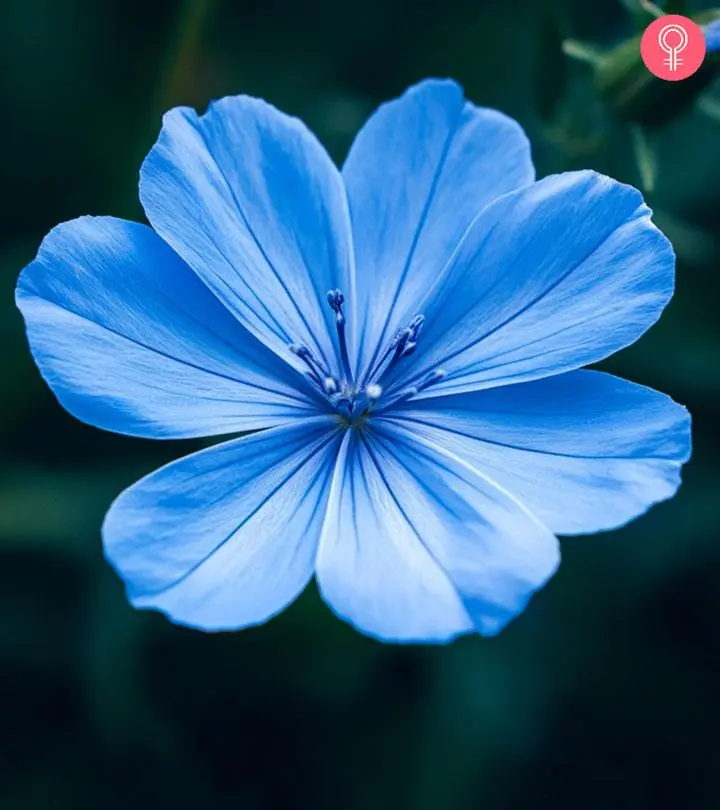
Image: Midjourney/ StyleCraze Design Team
“Blue color is everlastingly appointed by the deity to be a source of delight.” — John Ruskin
The beautiful blue flowers convey the message of love, desire, and the supreme struggle to reach the zenith. They are one of the rarest flowers found in the world and create a contemplative mood by virtue of their cooling and calming effect.
At the same time, it is believed that blue flowers slow down metabolism and reduce appetite. Blue is a color that is associated with intellect and spirituality. It has calming effects and helps one to sleep better.
While light blue is the color of serenity, calmness, and peace, dark blue conveys importance and confidence. However, the gorgeous blue flowers stand for loyalty, trust, intelligence, wisdom, truth, faith, and confidence and give a sense of stability, confidence, honesty, and security.
Mary Mageau, a nature lover and a blogger, recalls her personal experience of basking in the bounties of beautiful blue flowers and shares a few of her favorite ones in her blog, including the morning glory, hydrangea, and the iris. She feels mesmerized by the color, texture, and sheer joy exuded by these flowers and adds, “Last but not least is my very favorite blue flower, the Himalayan Blue Poppy. Once you have seen it, you will never forget its heavenly shade of blue (i).”
The Loveliest Blue Flowers In the World
Here are some of the most beautiful blue flowers found across the globe.
In This Article
1. Blue hydrangea:
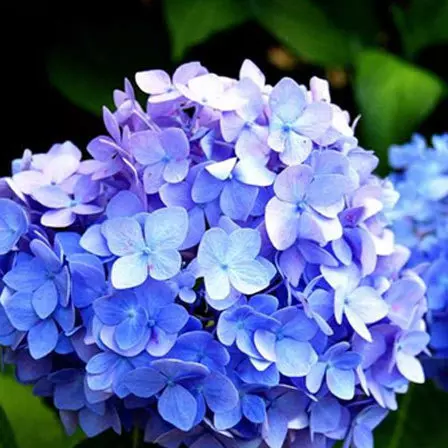
Scientific Name: Hydrangea macrophylla
Blue hydrangea is an absolutely breathtaking flower. Some blue hydrangeas come in vivid and striking colors, while some are in subtle shades like powder blue or sky blue. The shades of blue vary according to the alkalinity of the soil. Blue hydrangea flowers convey a heartfelt and strong feeling of love when given as a gift.
Symbolism: It is associated with forgiveness, regret, and rejection. If you want to apologize to somebody, give them a blue hydrangea.
Specific Growing Conditions & Care Tips
- Plant it in well-draining acidic soil (below 6.5 pH) rich in organic matter.
- It requires daily watering, so add organic mulches to the soil to retain moisture. via pinterest
 Did You Know?
Did You Know?Key Takeaways
- Blue flowers are not only beautiful but are seen as a symbol of love, trust, intelligence, loyalty, and confidence.
- These beautiful flowers can help calm the mood and convey a sense of serenity and peace.
- Some of the most beautiful blue flowers include hydrangea, grape hyacinth, delphinium, and clematis.
2. Delphinium:
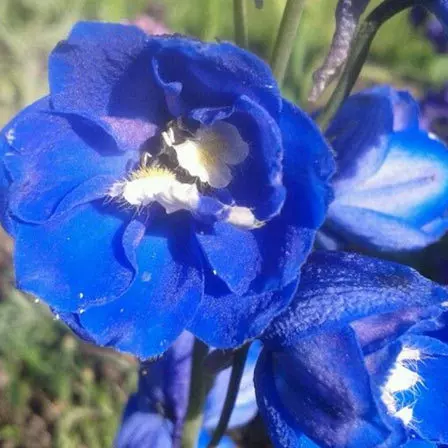
Scientific Name: Delphinium elatum
Delphinium flowers come in some of the truest shades of blue color. Its elegant beauty has inspired many tattoo enthusiasts to get life-like delphinium tattoos on their favorite skin spots.
Symbolism: This unique dolphin-shaped flower symbolizes nobility, wealth, fun, health, levity, ardent attachment, and big-heartedness. It is also considered a mystical plant believed to ward off negative energies.
Specific Growing Conditions & Care Tips
- Plant it in well-draining, loamy soil that has 6.5 to 7.0 pH.
- Add slow-released fertilizer every 2-3 weeks for proper bloom.
via pinterest
3. Dandelion:
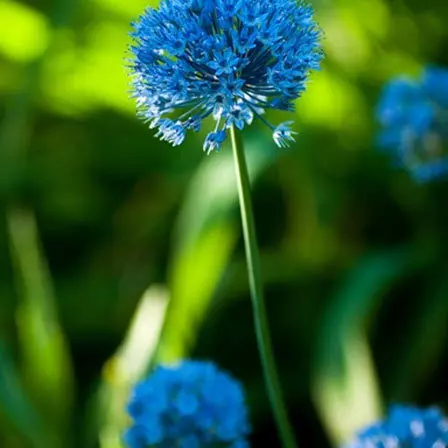
Scientific Name: Taraxacum
Dandelion is a popular flower in folklore and legends and has been symbolic in a variety of cultures. These flowers are native to Europe and Asia but are now available widely across the world.
Symbolism: It is the epitome of faithfulness, tranquility, hope, healing, and resilience. It also signifies change and the art of letting go.
Specific Growing Conditions & Care Tips
- Choose a partially shaded location to plant it.
- Water it daily, but ensure that the top two inches of the soil are dry before watering.
via pinterest
4. Grape Hyacinth:
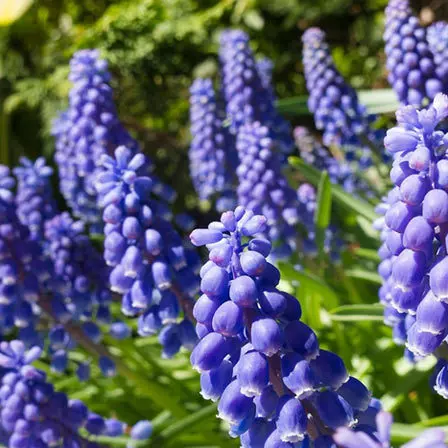
Scientific name: Muscari armeniacum
This flower is a very beautiful and unique bulb-shaped bloom that grows in clusters in mid-spring. It is found in purple, white, and yellow varieties.
Symbolism: Grape hyacinth is associated with rebirth, constancy, sincerity, and trust. It also represents a joyful spirit and liveliness.
Specific Growing Condition & Care Tips
- Plant it in a soil that has a pH between 6.0 to 7.0.
- Annual fertilization helps the plant, so add slow-release phosphorus-rich fertilizer to the soil before spring.
via pinterest
5. Clematis:
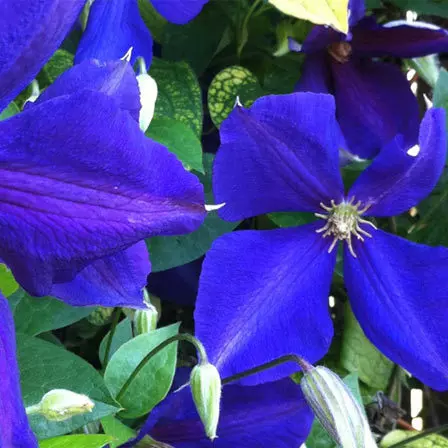
Scientific Name: Clematis virginiana
Clematis is a flowering climber plant that is mostly used for ornamental purposes. ‘Crystal fountain’, ‘Ice Blue’, and ‘Arbella’ are some true blue varieties of this flower. The meaning of clematis is mental prowess.
Symbolism: The blue clematis signifies faithfulness, ingenuity, intellect, and courage.
Specific Growing Condition & Care Tips
- Plant it in well-draining soil with a neutral to slightly alkaline pH. If the soil is acidic, periodically sweeten it with limestone to make it ideal for Clematis.
- Mulch around the roots to preserve moisture and keep the soil cool.
via pinterest
6. Bluestar:
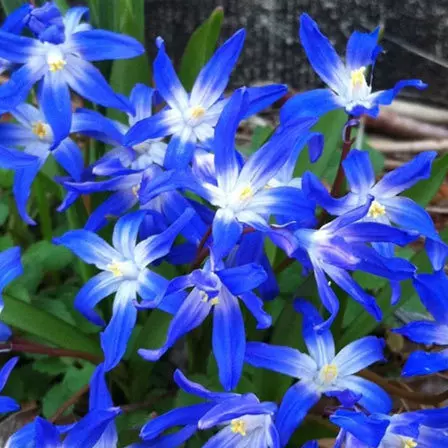
Scientific Name: Amsonia tabernaemontana
Blue star flower is a perfect blue flower for gardens. It blooms in clear blue clusters on greenish-yellow foliage.
Symbolism: This vibrant flower signifies steadfastness and affection.
Specific Growing Condition & Care Tips
- Plant it in well-draining soil that has acidic to neutral pH.
- Apply a layer of mulch at the base of the plant to retain the moisture and suppress the formation of weeds.
via pinterest
7. Bellflower:
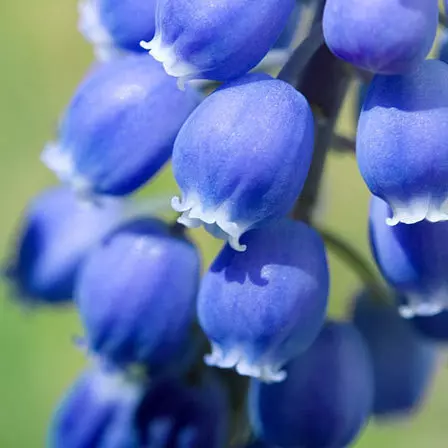
Scientific name: Campanula rapunculoides
Bellflowers, with their charming starry or bell-shaped blooms in a palette of violet, purple, and white, are a sight to behold. The long-stemmed varieties, in particular, make for stunning cut flowers. Imagine a pearl deep blue cup-shaped flower with light yellow centers, its dark green foliage a perfect complement to the blue. Bellflowers, often associated with the realm of fairies, are even referred to as ‘fairy thimbles.’
Symbolism: Bellflowers are not just beautiful; they also carry a profound symbolism. They are associated with true love, steadfastness, humility, constancy, and gratitude, evoking a sense of deep connection and sentimentality.
Specific Growing Condition & Care Tips
- Plant it in loamy soil with good drainage.
- Add slow-release manure to boost its growth.
via pinterest
8. Balloon Flower:
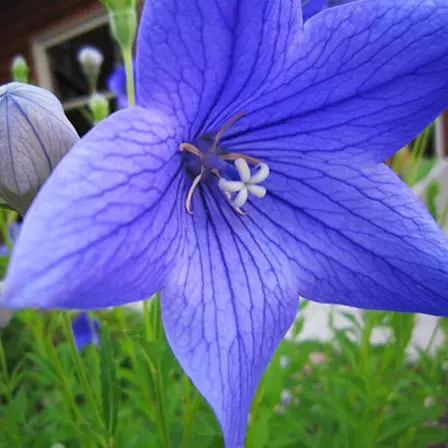
Scientific name: Platycodon grandiflorus
Balloon flowers are balloon-shaped buds that open to beautiful blue, pink, or white-shaped blooms with striking red pistils. This flower can be used best for decoration purposes or for flower arrangement with this flower as a lovely backdrop. These flowers would make a great gift for some who are extremely special to you.
Symbolism: This beautiful flower stands for endless love, honesty, and obedience. It embodies the spirit of earnest devotion and respect.
Specific Growing Condition & Care Tips
- Plant in rich, loamy soil that has a pH between 5.5 to 7.5.
- Ensure the soil is consistently moist but not very wet.
- Add slow-release fertilizer to promote healthy growth.
via pinterest
9. Aster:
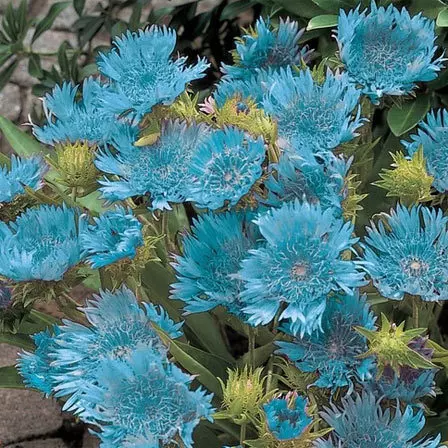
Scientific name: Symphyotrichum laeve
Aster, the late bloomer of the year, graces the garden with its vibrant colors of red, purple, blue, pink, yellow, and white. What’s more, these beautiful blooms are believed to possess unique healing properties. In ancient times, it was thought that burning aster flower leaves could ward off evil and its associated elements, adding a fascinating layer to this plant’s allure.
Symbolism: The aster flower, with its late bloom, signifies not just the end of the year but also love, valor, and peace. It is a symbol deeply rooted in our cultural history, also linked with the ideas of wisdom and faith, making it a plant of profound significance and beauty.
Specific Growing Condition & Care Tips
- Plant it in well-draining, loamy soil.
- Add a fine layer of balanced fertilizer along with a 2-inch layer of mulch around the base of the plant to boost growth.
via pinterest
10. Morning Glories:
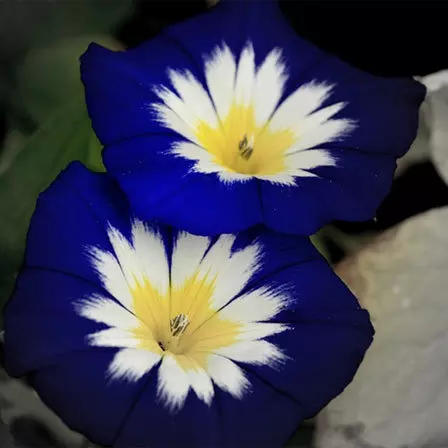
Scientific name: Ipomoea purpurea
Morning Glory is a saucer-shaped flower that blooms in colors like blue, yellow, purple, red, and pink. This star-shaped blue flower species is aptly named morning glory as the flower blooms during the day and dies by evening. It is used for ornamental purposes at weddings and parties.
Symbolism: It symbolizes love, pure affection, and a renewed sense of hope.
Specific Growing Condition & Care Tips
- Plant it in a soil rich in organic matter with a neutral pH (6.0 to 6.8).
- Add low-nitrogen fertilizer every four weeks to promote healthy bloom.
via pinterest
11. Blue Hibiscus Flower:
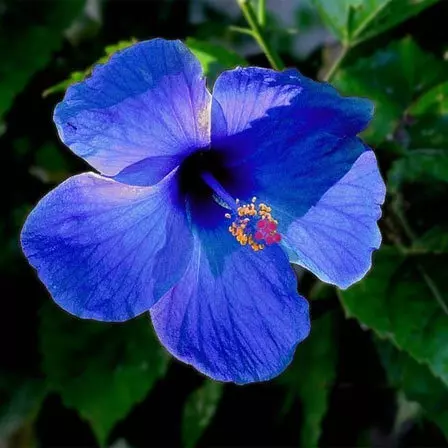
Scientific name: Alyogyne huegelii
Blue Hibiscus flowers are rare to be found and look exotic in shape and color. This beauty glorifies the flower land, representing fertility.
Symbolism: Hibiscus generally stands for delicate beauty, while its blue variety symbolizes depth, infinity, serenity, and unexplainable splendor.
Specific Growing Condition & Care Tips
- Plant it in fertile and loamy soil (slightly acidic pH) with a good drainage facility.
- Add a fertilizer to the soil that is low in phosphorus, moderate in nitrogen, and high in potassium.
via pinterest
12. Impatiens Flower:
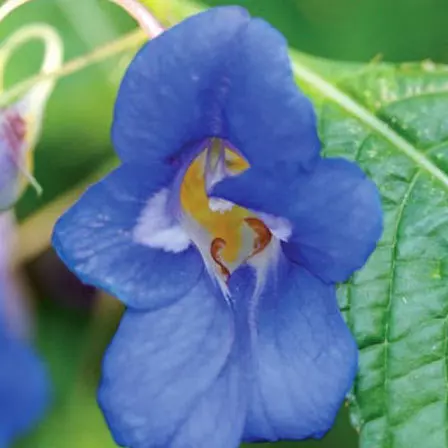
Scientific name: Impatiens namchabarwensis
The Impatiens flower comes in two varieties: flat-shaped and orchid-shaped. In medieval times, impatiens flowers were called ‘Our Lady’s Earrings’.
Symbolism: This flower symbolizes motherly love and affection.
Specific Growing Condition & Care Tips
- Plant it in well-drained soil with a pH level between 6.0 and 6.5.
- Add water-soluble fertilizer every two weeks or slow-release granular fertilizer to boost growth.
via pinterest
13. Iris:
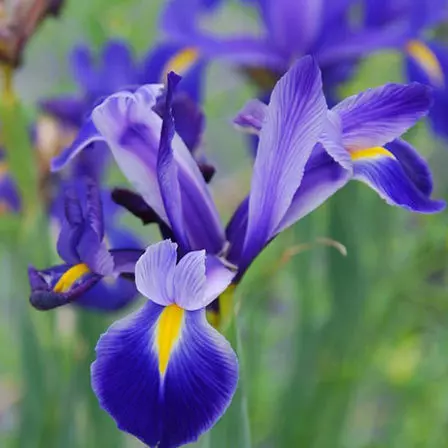
Scientific name: Iris versicolor
The Iris flower is associated with faith, wisdom, cherished friendship, hope, and valor. It was used in medieval times in the Mary Gardens. The blade-shaped foliage of this flower denotes sorrows that pierce the heart. Iris has been recognized as the dancing spirit of the early summer for its different colors. Its fluttering petals often remind me of butterfly wings flapping gently in the breeze.
Symbolism: This flower represents hope and everlasting faith. It also evokes a sense of serenity and calmness.
Specific Growing Condition & Care Tips
- Plant it in a slightly acidic (6.8 to 7.0 pH) soil rich in organic matter.
- Add all-purpose fertilizer early spring to the soil to ensure healthy growth.
via pinterest
14. Violet Flower:
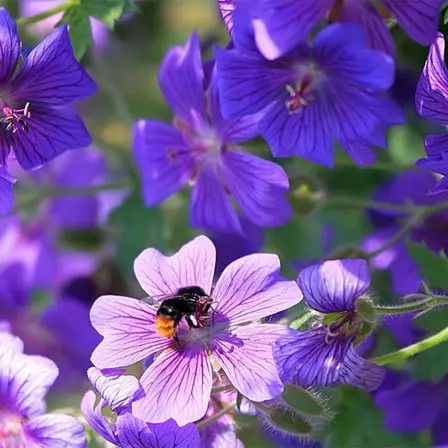
Scientific Name: Viola orodata
This pretty blue flower is edible, and its essence is often used in desserts white its petals are used to decorate salads and desserts.
Symbolism: It denotes affection, modesty, watchfulness, love, and happiness. It also is linked with the concept of the eternal cycle of life.
Specific Growing Condition & Care Tips
- Plant it in fertile soil that does not lose moisture easily.
- Add a fertilizer rich in seaweed to the soil to promote healthy bloom.
via pinterest
15. Gentian:
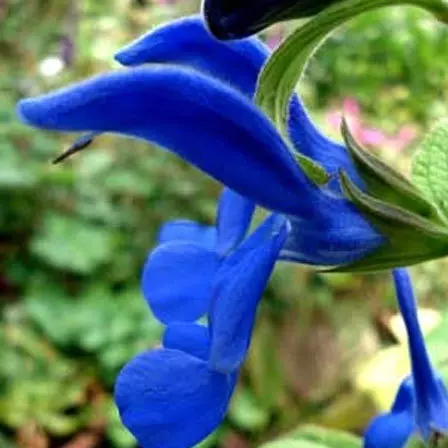
Scientific name: Gentianopsis crinita
Gentian is a true blue-colored flower with smooth green lance-shaped leaves which is highly attractive to butterflies and hummingbirds. Blue gentian is a very unique flower prevalent only in Europe. This unusual-looking flower is mostly used as an alternative to traditional roses and daisies.
Symbolism: Blue gentian represents justice and determination. It also conveys loveliness, intrinsic value, and femininity.
Specific Growing Condition & Care Tips
- Plant in loamy to sandy-loamy soil that has a well-drainage facility.
- Add balanced fertilizer, preferably one rich in phosphorus, to the soil.
via pinterest
16. Forget me not:
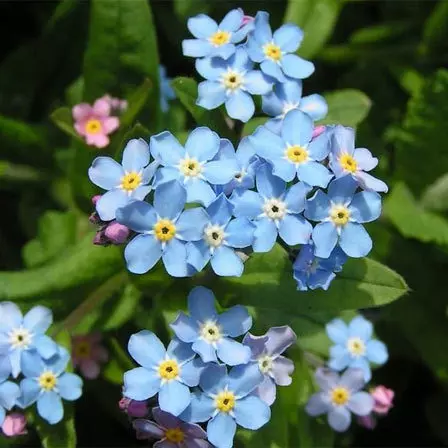
Scientific Name: Myosotis scorpioides
This is a pretty little blue flower with yellow stamens and blooms, mainly in summer. In the 15th century, it was believed that the wearers of this flower would not be forgotten by their lovers.
Symbolism: It is considered a prominent symbol of true love, fidelity, and faithfulness.
Specific Growing Condition & Care Tips
- Plant it in consistently moist soil that has a neutral pH.
- Fertilize with compost or all-purpose fertilizer every year.
via pinterest
 Trivia
Trivia17. Bachelor Button Flower:
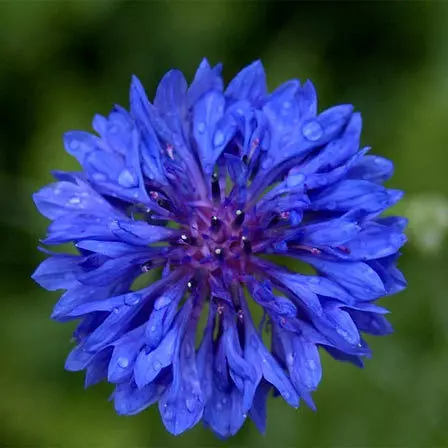
Scientific Name: Centaurea cyanus
This flower is more commonly known as cornflower, basket flower, and boutonniere flower. It is among the most beautiful flowers in the world and was prized historically for its pigment. In the olden days, bachelors would wear this flower to indicate their love for their beloved. If the love was not reciprocated, the flower would die quickly. It is also a national flower of Poland.
Symbolism: The flower symbolizes celibacy, singlehood, hope for love, delicacy, and blessedness.
Specific Growing Condition & Care Tips
- Plant it in well-draining soil and cover it with half-inch topsoil.
- Add a layer of mulch at the base to preserve the water.
via pinterest
18. Blue Daisy:
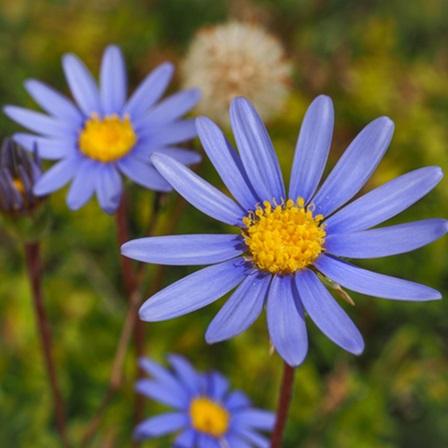
Scientific name: Felicia amelloides
Daisies are classic flowers that are loved by one and all. Garden marguerite daisies are beautiful and look even more unique and beautiful because of their blue color. These flowers are truly remarkable and have fringe-like petals surrounding a yellow and green center.
Symbolism: It symbolizes innocence, simplicity, adoration, and appreciation.
Specific Growing Condition & Care Tips
- Plant it in lightweight, well-draining soil, preferably on raised beds.
- Deadhead the plant from time to time to encourage better bloom.
19. Ipomoea flower:
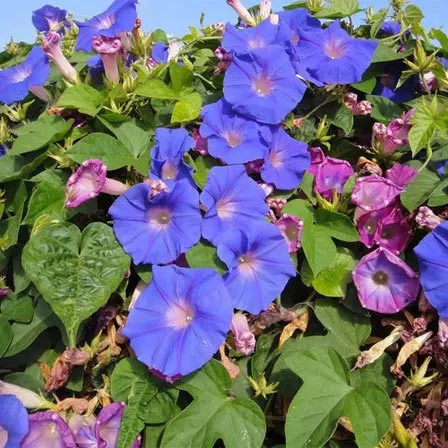
Scientific Name: Ipomoea indica
This is one of the loveliest flowers with huge trumpet-shaped petals in deep azure color. It opens its petals every dawn to embrace the new day and perishes before noon. The bright blue flower contrasts very well with rich green leaves. These flowers are born in clusters on high stems.
Symbolism: This flower stands for spiritual enlightenment and purity.
Specific Growing Condition & Care Tips
- Plant it in well-drained soil rich in organic matter.
- Use water-soluble fertilizer every two weeks to encourage vibrant bloom.
via pinterest
20. Blue calla lilies:
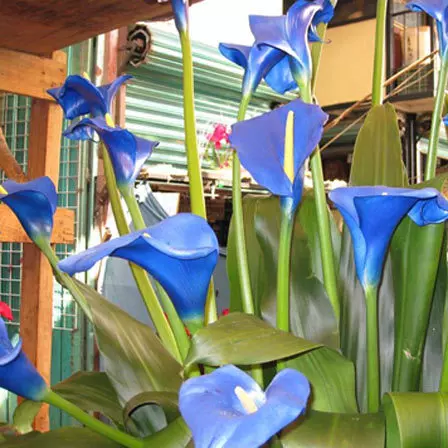
Scientific Name: Zantedeschia aethiopica
Blue calla lilies are magnificent-looking flowers often used for weddings, parties, baptisms, and even funerals. These exotic-shaped flowers can be used on any occasion as an expression of gratitude and appreciation.
Symbolism: It symbolizes royalty, serenity, peace, and tranquility. In the Romantic period, this flower was also associated with love and desire.
Specific Growing Condition & Care Tips
- Plant it 3-4 inches deep in porous soil. Ensure the soil has a good drainage facility.
- Add slow-release fertilizer high in nitrogen for proper growth.
via pinterest
21. Blue orchids:
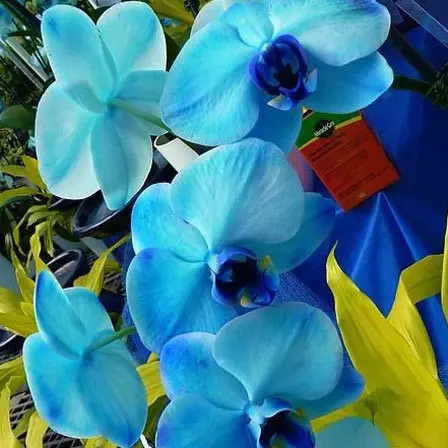
Scientific name: Vanda coerulea
Orchids are highly coveted flowers that represent luxury, beauty, and strength. Blue orchids are astonishingly beautiful flowers and are capable of attracting even people who do not appreciate flowers much. These flowers are quite rare to find but are extremely popular for their beauty. Blue orchids are associated with the deep and vast ocean for their blue and white color.
Symbolism: These flowers represent tranquility, delicate beauty, power, and stability.
Specific Growing Condition & Care Tips
- Plant it in lightweight soil that has a neutral pH. Ensure the soil holds moisture for a long time.
- Use high-phosphorus fertilizer to strengthen the plant and boost its blooming capacity.
via pinterest
22. Blue carnation:
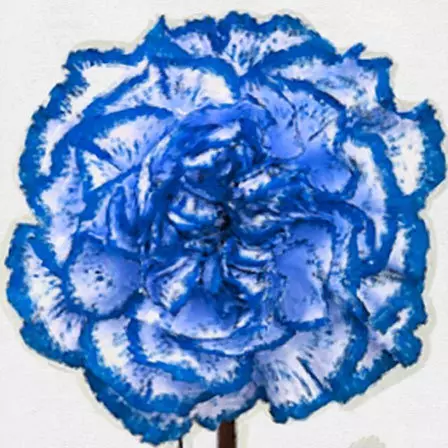
Scientific Name: Dianthus caryophyllus
Blue carnations are fun and colorful flowers making them a perfect choice for party decorations. These charming flowers spread joy and elegance and are used widely for special occasions and gifting purposes. They are widely used during weddings, indicating the clear response to the feeling of pure love a groom has for his bride.
Symbolism: The light sky blue color of this flower symbolizes peace and partiality. The flower also represents truth.
Specific Growing Condition & Care Tips
- Plant it in a well-draining soil with a pH between 6.0 and 6.5.
- Add a slow-release fertilizer during the spring and mid-summer time to encourage growth.
via pinterest
23. Columbine:
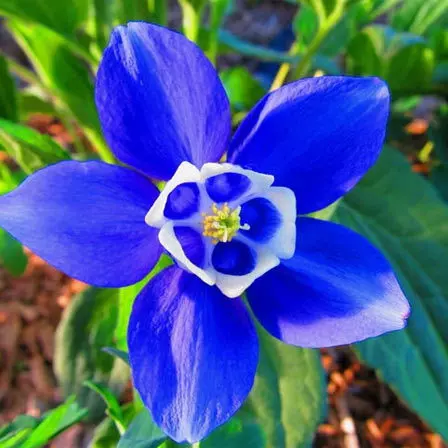
Scientific name: Aquilegia vulgaris
Columbine is a plant from the ranunculaceous genus with seemingly delicate petals and colored sepals that give the appearance of a bunch of pigeons. This blue flower’s name is derived from the Latin word ‘Aquila’ and stands for ‘dove’ in the language of flowers. The leaves are dark and bluish green in color and the flower blooms in a beautiful blue color with ferny foliage. It comes in colors like yellow, pink, red, maroon, violet and white.
Symbolism: The flower stands for faith, hope, and love.
Specific Growing Condition & Care Tips
- Plant in well-drained soil that stays evenly moist. This flower thrives in loamy and sandy soil.
- Add a good layer of well-rotted manure to the top of the plant to promote growth.
via pinterest
24. Anemone:
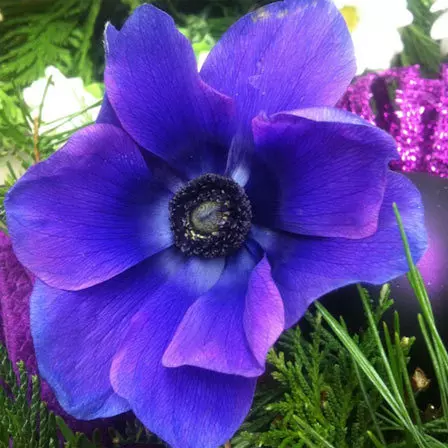
Scientific name: Anemone apennina
Anemone comes in bright vivid colors and blooms in spring, summer, and fall. This flower is believed to bring luck and protect against evil and other harmful forces. It also carries magical and prophetic tales with itself and thus is called anticipation in the language of flowers.
Symbolism: It represents sincerity and protection from evil.
Specific Growing Condition & Care Tips
- Plant it in soil that remains consistently moist.
- Fertilize it with well-balanced fertilizer during early Spring and mulch every year.
via pinterest
 Trivia
Trivia25. Brunnea:
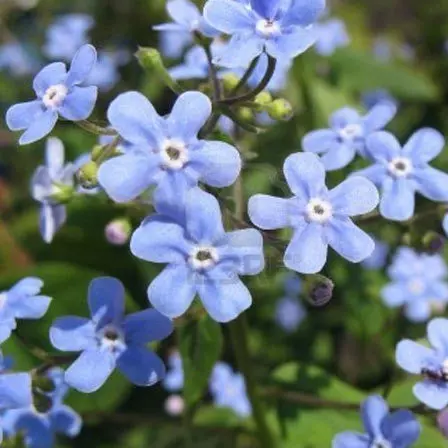
Scientific Name: Brunnera macrophylla
Brunnea is a 5-petaled tiny blue flower with sprays held above the foliage. These airy sprays of blue flowers appear in early spring and have a striking resemblance to forget me not flowers.
Symbolism: This flower can embody serenity, innate strength, and peace.
Specific Growing Condition & Care Tips
- Plant it in woodland beds or areas with dappled shade.
- Regularly remove weeds and cut off brown leaves to ensure proper growth.
26. Lobelia Flower:
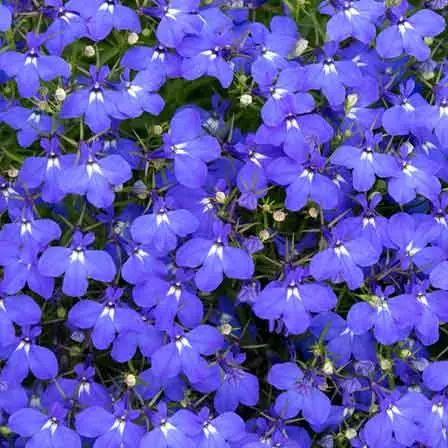
Scientific Name: Lobelia siphilitica
Lobelia, a charming flower, graces gardens with vibrant hues that can range from deep blue and purple to bright pink and white. This delicate perennial is known for its slender stems and elongated clusters of tubular blossom. It thrives in well-drained soil and partial shade, which means it can be grown in different kinds of garden arrangements and containers. Its profusion of blossoms attracts butterflies and hummingbirds which are always a welcome addition to a garden’s biodiversity and the landscape. No wonder the Lobelia flower, with its graceful appearance and vivid colors, is a favorite among garden enthusiasts for its enduring charm!
Symbolism: It conveys the idea of love, healing, peace, and prosperity.
Specific Growing Condition & Care Tips
- Plant it in well-amended soil with a slightly acidic pH between 6.0 and 7.0.
- Add granular fertilizer when planting and use all-purpose liquid fertilizers every 3-4 weeks to support its growth.
These vibrant flowers attract bees and butterflies, helping you do a small part in maintaining a healthy ecosystem. Listed some common growing tips for blue flowers, so your garden always looks stunning.
Primary Growing Conditions For Blue Flowers
The right amount of water in the soil and direct sunlight is essential for the growth of blue flower plants. These help them bloom and survive a long time. Some important growing conditions to be mindful of are:
- Well-draining Soil: This allows excess water to flow out easily, preventing water-logging. Excess water can damage the roots of the plants.
- Full-To-Partial Sunlight: Ensure the planting area is exposed to direct or at least partial sunlight. The plant must thrive and grow naturally to be able to bloom.
Note:
Different plants have different needs. Therefore, research the plants in detail to provide them with the best environment.
Once you have found the right place for your plant, you have to care for it daily to maintain its beauty. The next section shares the basic ways you can care for your plant. Read on!
Caring Tips For Blue Flowers
There are a lot of things that one must do regularly to keep the beauty of their plants intact and maintain their growth. Here are some of the top tips you can follow:
- Water the plants regularly to keep the soil moist. However, ensure there are no water-logging issues.
- Trim the plants occasionally to eliminate excess growth and dead branches to promote healthy growth.
- Use safe fertilizers to provide essential nutrients to the plants, aiding their growth.
- Check for pests daily and take necessary precautionary measures to avoid harm.
via pinterest
Next, let’s learn why people with an interest in landscaping search for plants that grow blue flowers in particular. Scroll down.
How Can Blue Flowers Enhance Landscaping?
Incorporating the unique and vibrant blue flowers into your garden is a brilliant way to add elegance to your outdoor space. Blue flowers are rare, and they look breathtaking. They can add depth to your garden and also create a soothing contrast. Read on to learn how blue blooms can beautify your landscape design.
- The color blue evokes a sense of calmness. It soothes the eyes and lifts everyone’s mood. Adding blue flowers to your garden will make it look serene. A passionate gardener who loves blue flowers has shared in her blog, “According to color psychology, the color blue elicits feelings of calmness or serenity. It is often described as peaceful, tranquil, secure, and orderly. (ii)”
- Blue flowers can create a harmonious contrast with red, green, and yellow flowers, adding dimension and depth to your garden.
- If you have a themed garden, blue flowers will complement the water elements and create a cooling appeal.
- Blue flowers like salvia and lavender attract pollinators, promoting biodiversity. By incorporating these flowers into your garden, you’re not just adding beauty, you’re also contributing to the health of the ecosystem. A garden filled with insects and pollinators looks picturesque, and you can feel proud of your role in supporting the environment.
Infographic: Top 10 Brilliant Blue Flowers For Your Garden
Blue flowers are some of the most elegant and graceful blooms in the world of florals. Though the color is quite difficult to find naturally in flowers, there are around 25 beautiful blue flowers across the world that can be suitable to plant in your garden. From the rich hues of cobalt, sapphire, and navy to the soft shades of indigo and sky blue, blue flowers are a timeless and beautiful choice for any occasion. Awestruck? Well, there are some particularly beautiful blue flowers that you have to keep an eye on.
Check out the infographic below to know about the top ten brilliant blue flowers to add to your garden to enhance the beauty of your home.
Some thing wrong with infographic shortcode. please verify shortcode syntaxBlue is a dreamy color related to the emotions and hopes of people. It has a cooling and calming effect and is often associated with spirituality and intellect. Blue flowers are quite rare to be found. The shades of blue symbolize different fortunes. Blue hydrangea, delphinium, dandelion, grape hyacinth, and clematis are the most beautiful blue flowers found globally. Blue periwinkle, larkspur, lupine, blue pansy, petunia, and verbena are some of the other beautiful blue flowers that you can add to your floral arrangement. With their unique shapes and shades of blue, these flowers are sure to impress and delight. However, some believe that they may reduce appetite and slow down metabolism. Hence, practice caution and consult your health care provider for more information.
Illustration: Most Beautiful Blue Flowers
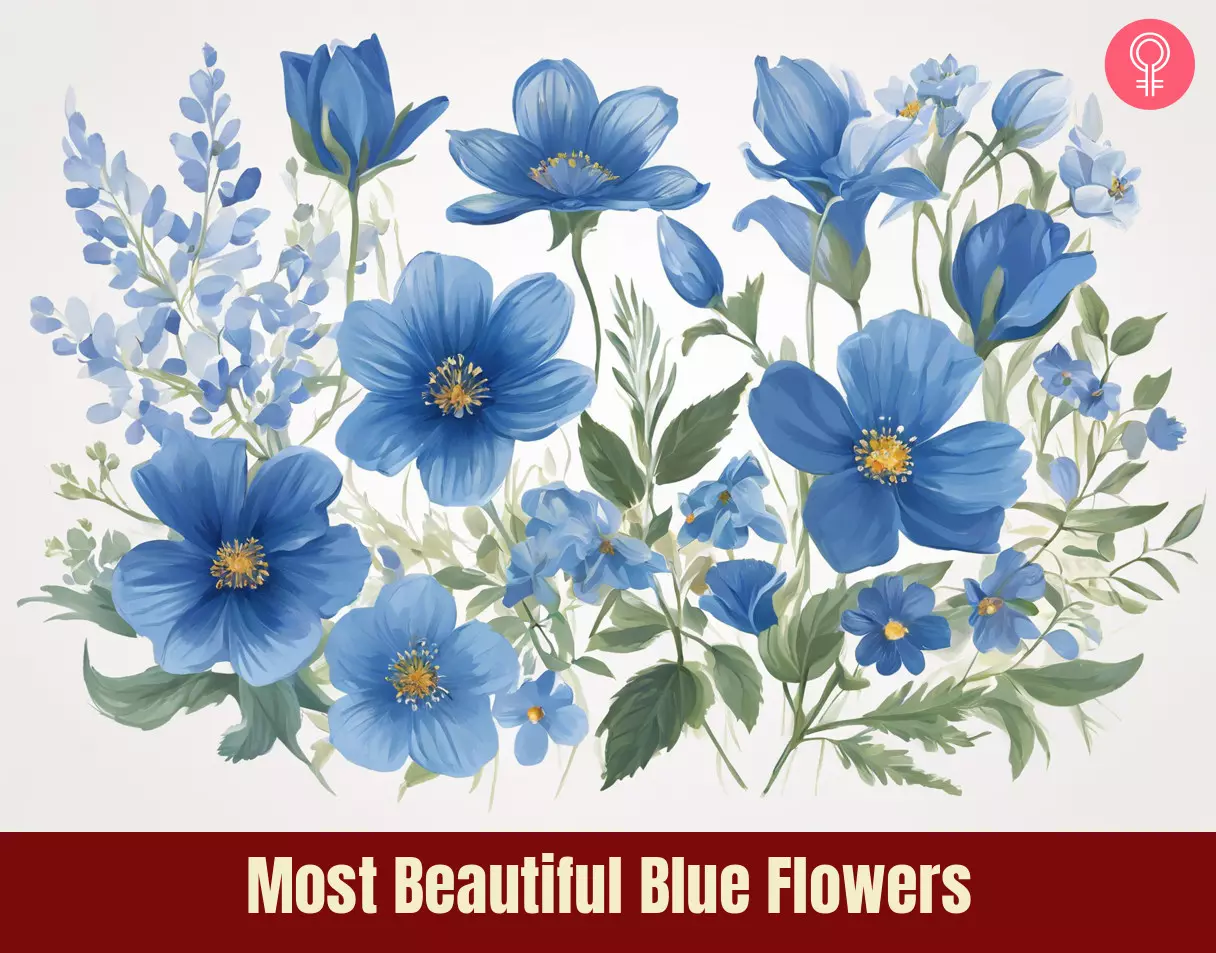
Image: Stable Diffusion/StyleCraze Design Team
Frequently Asked Questions
Is there a true blue rose?
No. A blue rose does not exist in nature. You can either dye a white rose blue or opt for a genetically modified blue rose.
Why are blue flowers so rare?
Unlike other colors in nature, blue pigments are very rare in flowers. Hence, natural blue flowers are uncommon to find.
Which plant is known as the blue plant?
Brunonia, also known as the blue pincushion, is an Australian perennial herb that produces blue five-lobed flowers. It is also called the blue plant.
What are some popular blue flowers for attracting bees and butterflies?
Lobelia, Blue Hydrangea, and Delphinium are some popular flowers full of nectars. They attract many bees and butterflies to the garden.
Need planting tips and advice to bless your surroundings beautiful blue blooms? Take a look at this video for 65 different types of the finest and most captivating blue flowers.
Personal Experience: Source
StyleCraze's articles are interwoven with authentic personal narratives that provide depth and resonance to our content. Below are the sources of the personal accounts referenced in this article.
(i) Nature As Art And Inspirationhttps://marymageau.wordpress.com/tag/blue-flowers/
(ii) Blue Flowers
https://hortophile.wordpress.com/2011/07/13/blue-flowers/
Read full bio of Ramya Karamsetti
Read full bio of Madhumati Chowdhury



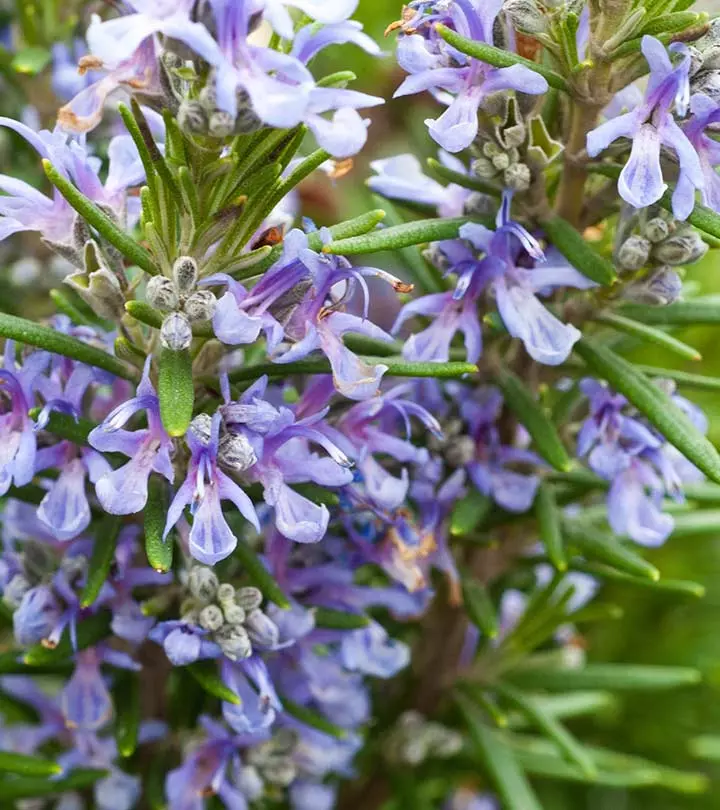
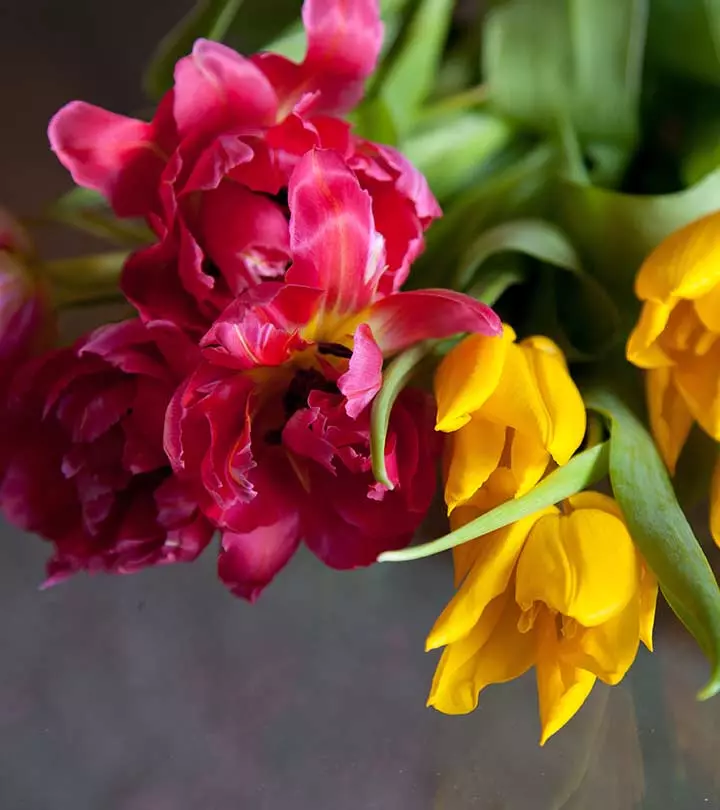
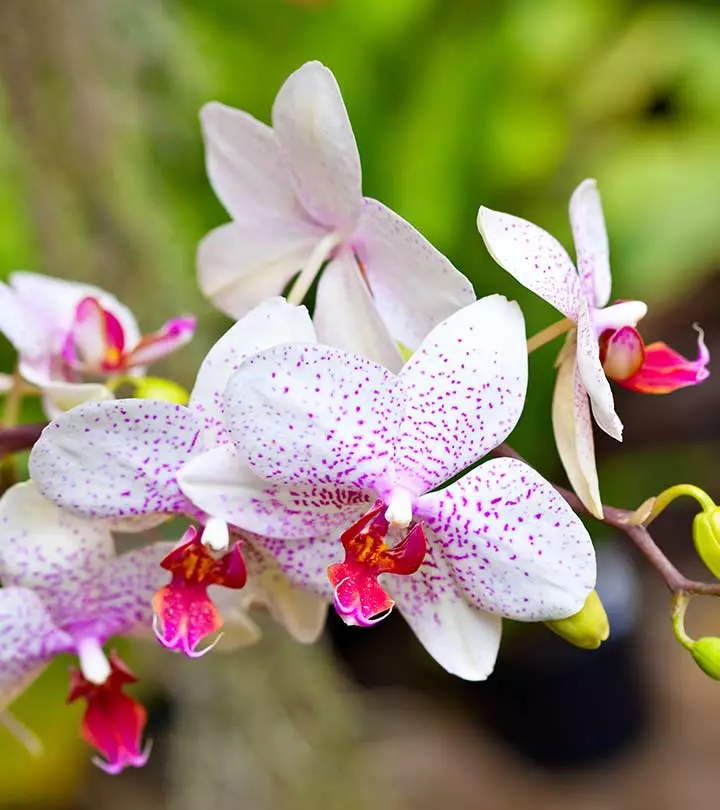
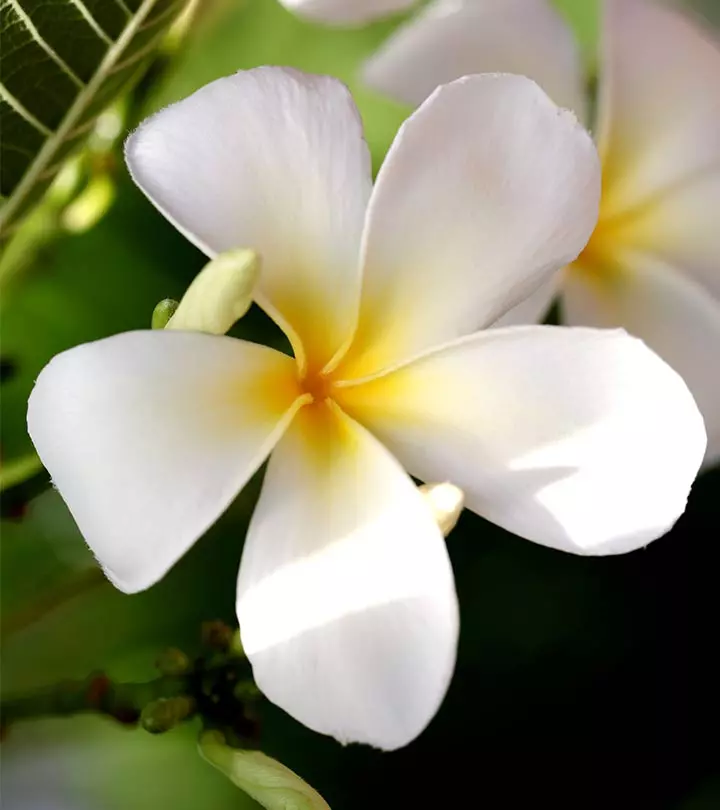
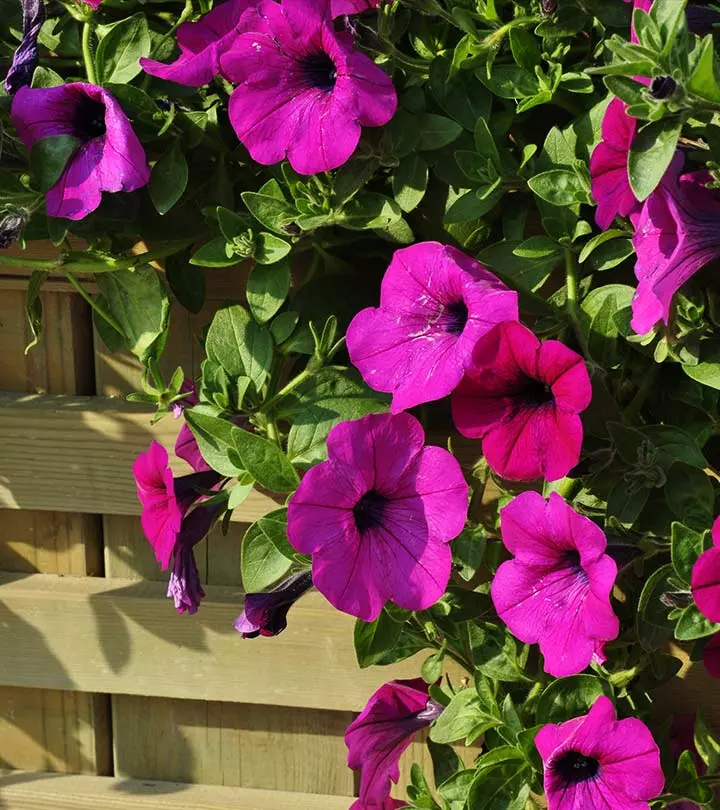
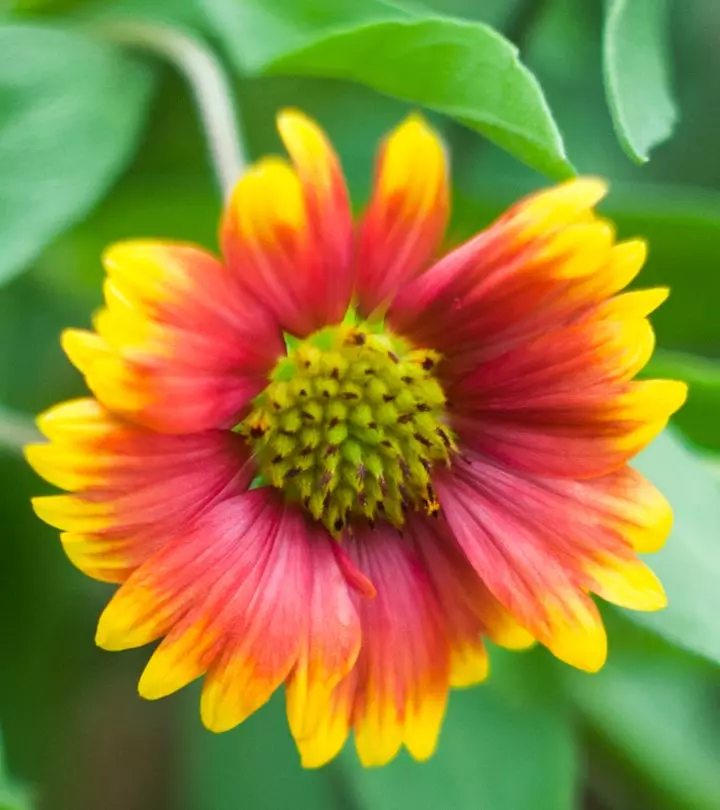
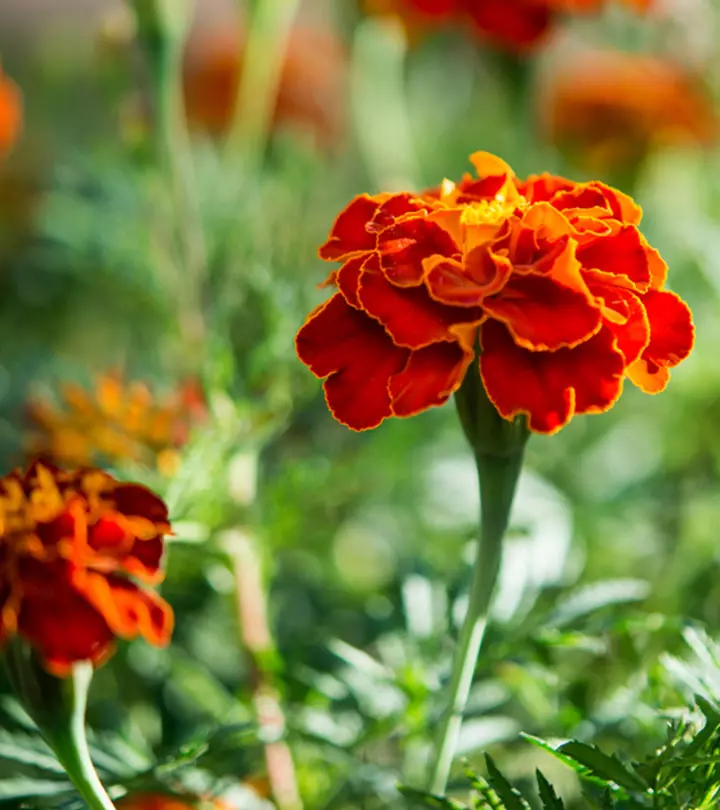
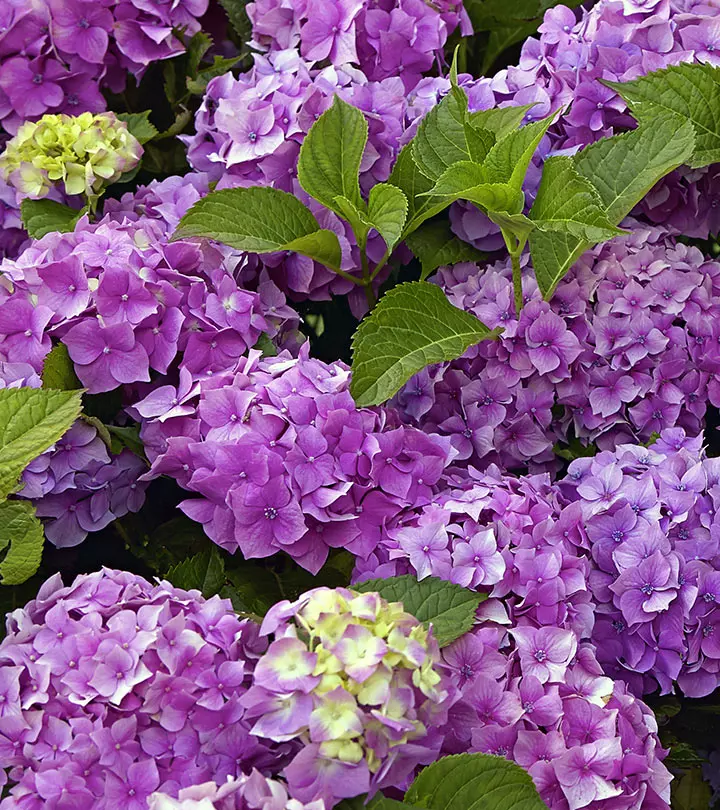

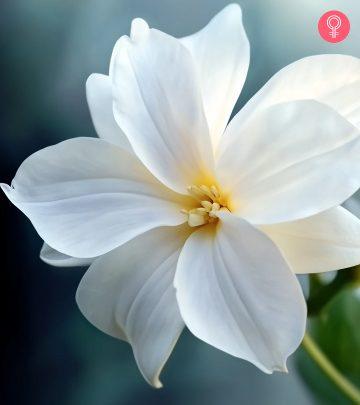
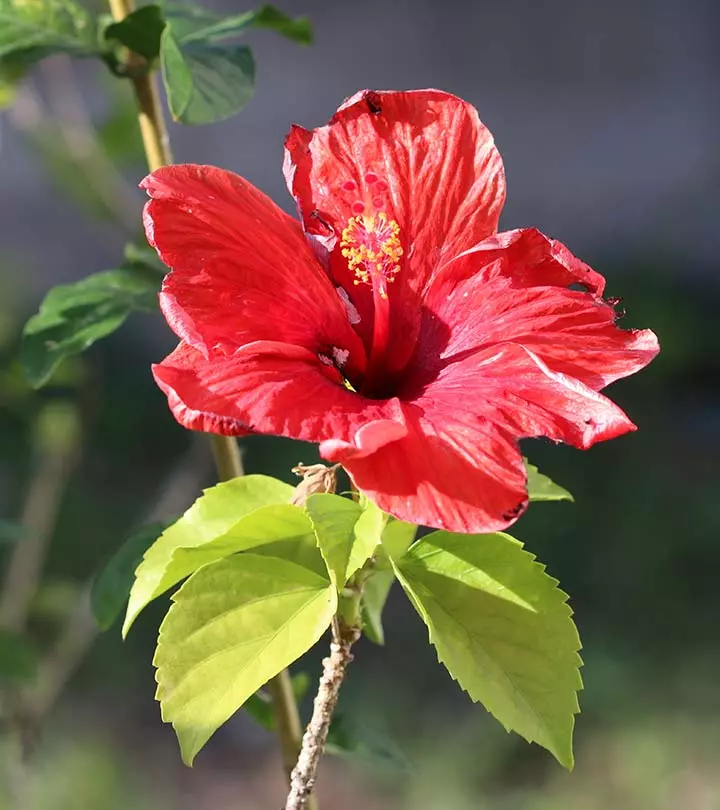
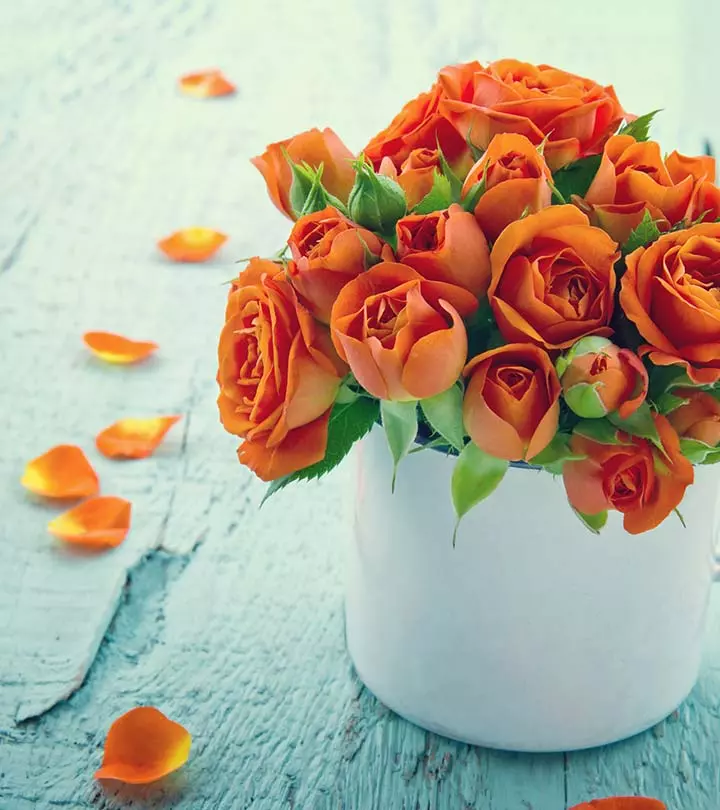
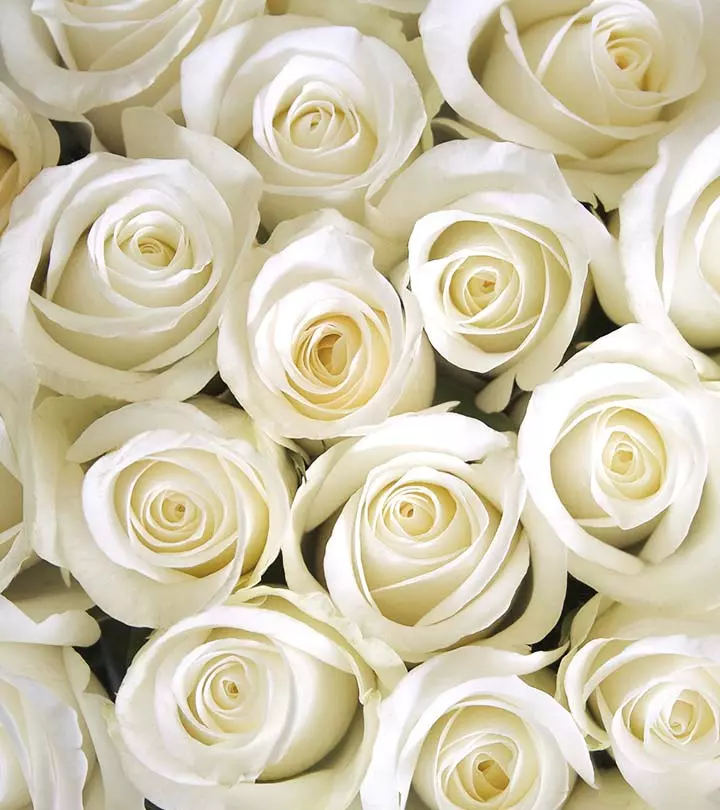

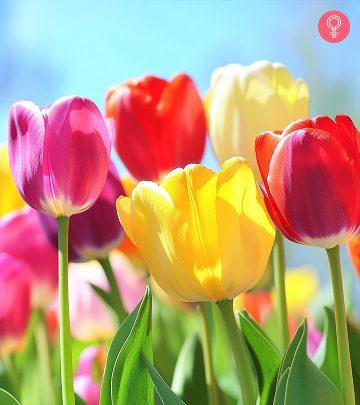
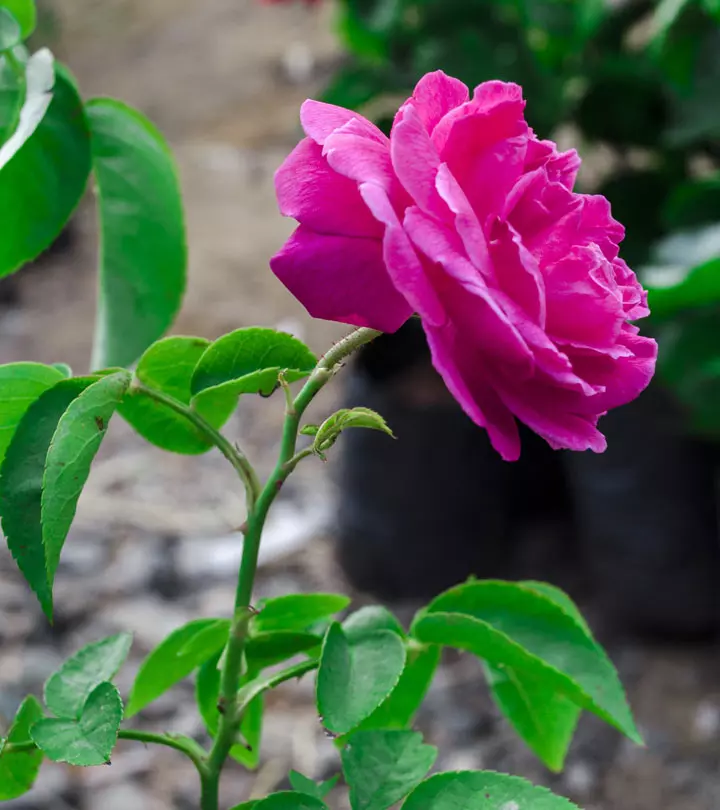
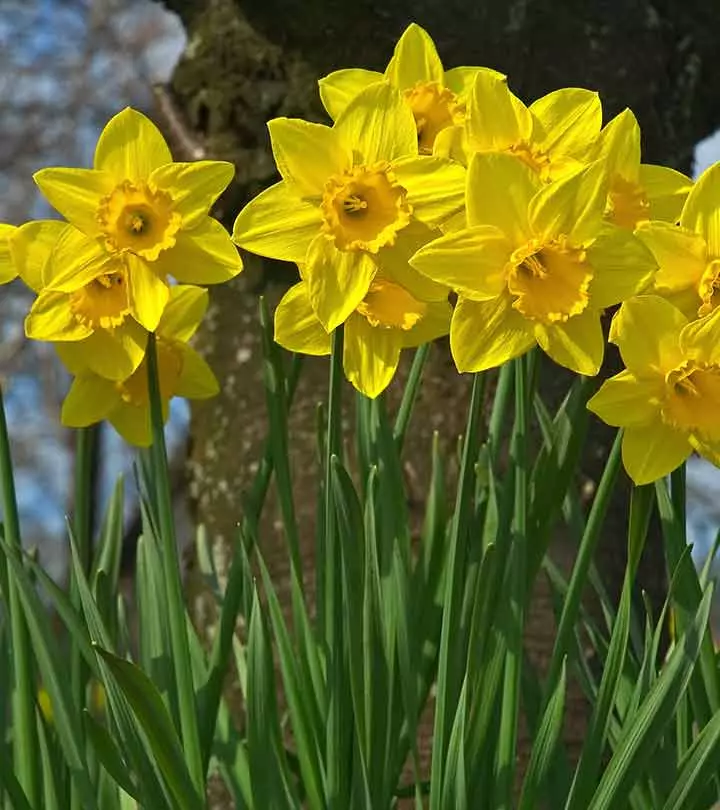
Community Experiences
Join the conversation and become a part of our empowering community! Share your stories, experiences, and insights to connect with other beauty, lifestyle, and health enthusiasts.